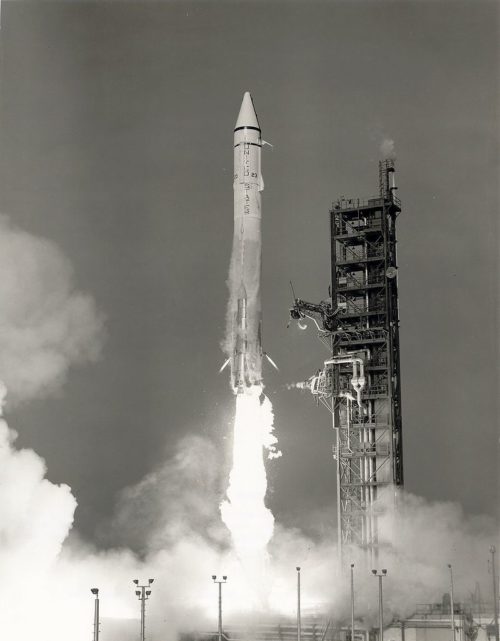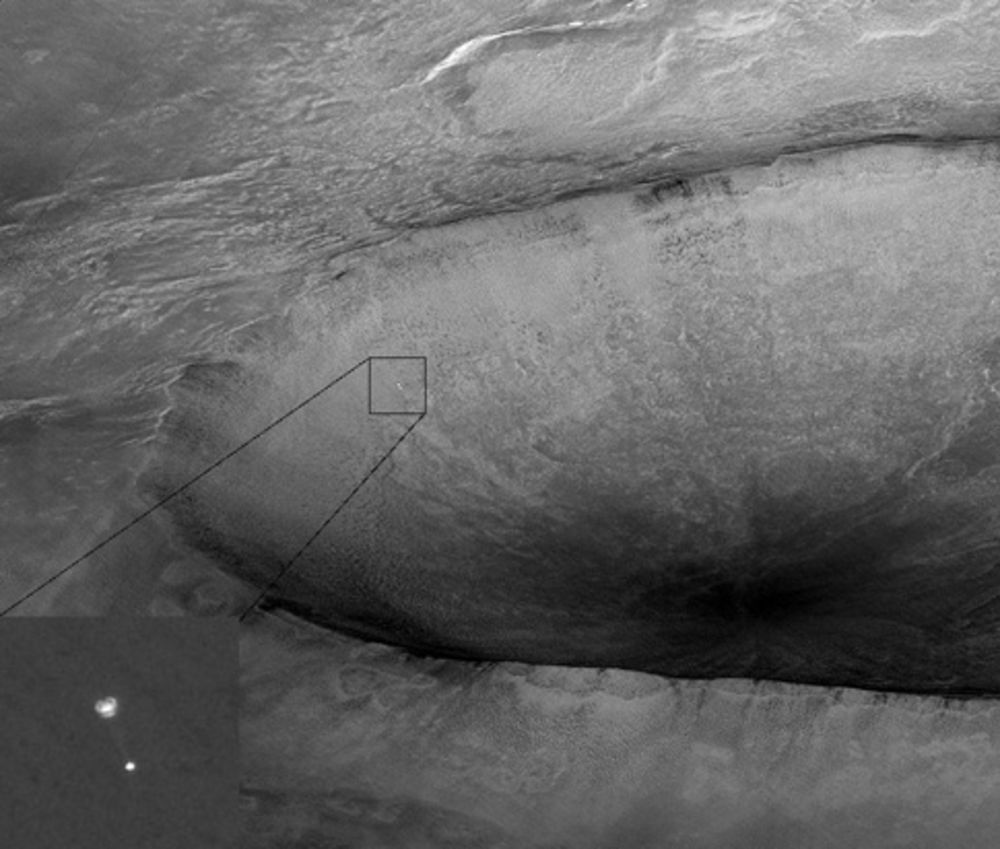
Less than four weeks now remain before a mighty United Launch Alliance (ULA) Atlas V booster lifts off from Space Launch Complex (SLC)-41 at Cape Canaveral Air Force Station, Fla., no sooner than 30 July, to deliver America’s latest robotic explorer to Mars. The Perseverance rover is physically not dissimilar to its predecessor, Curiosity, which has since 2012 traversed the Martian surface at Gale Crater. Yet this new rover will carry a significantly expanded toolkit, and the first helicopter ever to be set free on an alien world, when it descends via SkyCrane to touch down in the geologically-rich Jezero Crater in February 2021.
Perseverance is an indicator of how far the United States has come in its quest to explore the intractable ochre landscape of Mars. Reaching Mars is no mean feat and as outlined in Part 1 of this article the planet guards its secrets jealously. Today’s article will look at a string of spectacular U.S. successes which have put orbiters around the Red Planet, landers onto its surface and rovers which have revealed tantalizing clues of a surprisingly Earth-like past.

It was more than a half-century ago, on 28 November 1964, when the machine that became first to enter orbit around Mars departed Earth for the last time. Only three weeks previously, Mariner 3 had suffered a launch vehicle malfunction, but its near-twin, Mariner 4, was blown by the fair winds of kinder fortune. It rose from Launch Complex (LC)-12 at Cape Canaveral Air Force Station and its Atlas booster inserted it perfectly into an Earth-parking orbit, then the Agena upper stage pushed it out of our planet’s gravitational well and onto a 7.5-month-long trajectory to reach Mars. Unlike Mariner 3, its four paddle-like solar arrays deployed perfectly and Mariner 4 became the first human-made vehicle in history to perform a close flyby of Mars on 14-15 July 1965.

Passing within 6,120 miles (9,846 km) of the planet’s surface, at a relative speed of 15,660 miles per hour (25,200 km/h), Mariner 4 shuttered 21 pictures using alternate red and green filters, together with several lines of a 22nd image. All told, these images covered a discontinuous swath representing one percent of Mars’ surface, which were then stored in the on-board tape recorder. Eight hours after Mariner 4’s signal was re-established with Earth, transmission of the images commenced. Each image was sent twice to ensure that none were missed or corrupted.

It took six full hours for each image to be transmitted back home. But since the spacecraft’s tape recorder was actually a spare—and not originally intended to fly aboard Mariner 4—there existed some uncertainty over its reliability. As a result, the numerical printout of the raw pixels from the first digital image was hand-drawn using a pastel set from a nearby art store. This verified that the camera worked and the hand-drawn image later compared favorably with the actual photograph.

The success of Mariner 4 showed Mars to be a misleadingly “dead” world, with much of the observed terrain exhibiting heavy cratering, a lack of water, a thin atmosphere and no trace of a magnetic field or radiation belts. Temperatures at the surface hovered around -100 degrees Celsius (-148 degrees Fahrenheit). Hope that Mars might prove distinctly Earth-like, it seemed, had received a rude awakening. It later became clear that Mariner 4’s imagery centered upon very ancient terrain, but these skewed findings contributed to a mistaken perception for many years that the planet was geologically inactive.

America’s next foray to the Red Planet came in the spring of 1969, with Mariner 6 and 7 launched from neighboring pads—Launch Complexes (LC)-36B and 36A—at Cape Kennedy. The two identical spacecraft rose atop Atlas-Centaur boosters on 25 February and 27 March, respectively, and both of their multi-month cruises to Mars were largely uneventful, with the exception of a loss of contact with Mariner 7 in July 1969, a week prior to closest approach. It was believed that a leaking battery had conspired to cause the communications glitch, which was quickly resolved. Both spacecraft flew past the planet at a distance of approximately 2,130 miles (3,430 km), almost three times closer than Mariner 4 had achieved. They took hundreds of photographs which covered about 20 percent of the surface, but their trajectories ironically carried them again over heavily-cratered regions, which meant they missed out on imaging giant northern volcanoes like Tharsis and the great equatorial canyon of Valles Marineris.

They did, however, reveal tantalizing evidence for ice-filled craters and polar caps, but it was not until Mariner 9 that perhaps Mars’ true geological scale became apparent. Launched via an Atlas-Centaur booster from LC-36B at the Cape on 30 May 1971, it reached its destination the following 14 November and just narrowly beat the Soviet Union’s Mars-2 and Mars-3 missions in becoming the first vehicle to enter orbit around the Red Planet. Its path carried it as close as 1,030 miles (1,650 km) and as distant as 10,480 miles (16,860 km), which enabled Mariner 9 to capture astonishing imagery of this unknown world. All told—and despite dust storms which enshrouded parts of the planet for many months—by October 1972 the spacecraft had acquired 7,329 images. Its cameras achieved a resolution as fine as 330 feet (100 meters) per pixel, mapping over 85 percent of the Martian surface and observing the planet’s twin moons, Phobos and Deimos. It also observed the continent-sized volcanic plateau of the Tharsis Bulge, revealed evidence of ancient wind and water erosion and discovered the enormous equatorial canyon of Valles Marineris, which was named in the Mariner Program’s honor.
A totally different Mars from the one seen by earlier Mariners had thus emerged from the shadows. And America’s next foray to the Red Planet would be totally different both in terms of complexity and challenge. With Project Viking, a pair of orbiters and landers would literally rewrite the textbooks about Mars. The orbiters were built for an operational lifetime of 120 days, the landers for about 90 days on the surface, but all lasted far longer. In fact, the Viking 1 lander endured for 2,307 days from its touchdown on 20 July 1976 through the end of its mission on 11 November 1982. It was a record which remained unchallenged and unbroken until the Opportunity rover eclipsed it in May 2010.

The billion-dollar program was the most expensive U.S. mission ever sent to Mars. Viking 1 lifted off atop a Titan IIIE-Centaur booster from Space Launch Complex (SLC)-41 at Cape Canaveral—the same location as will be used for Perseverance’s launch in a few weeks’ time—on 20 August 1975, followed by its identical twin, Viking 2, on 9 September. Although the Soviet Union’s Mars-3 had become the first vehicle to soft-land on Mars in December 1971, it was Viking 1 which would be first to alight smoothly on the planet and successfully complete its mission.

And those mission were spectacular in accomplishment and far-reaching in scope. The two orbiters performed admirably, with the exception of Viking 2, which sustained a propulsion system leak; yet between them they acquired over 73,000 images of the planet, as well as water-vapor mapping and thermal mapping of the surface. The landers, for their part, touched down on Chryse Planitia on 20 July 1976 (in the case of Viking 1) and Utopia Planitia on 3 September 1976 (for Viking 2). The orbiters and landers revolutionized human understanding of the possibility of water on Mars, revealing huge river valleys and erosion patterns and offering tantalizing insights into the constitution of the Martian regolith.

More than two decades would pass before America’s next successful explorer of the Red Planet. The Pathfinder mission launched from SLC-17B at the Cape on 4 December 1996 atop a Delta II and delivered the the Sojourner rover onto the surface. It was part of an aggressive new campaign by NASA, which sought to execute “a sustained program of exploration” of Mars. Deposited by a complex system of supersonic parachutes, solid-fueled rockets and airbags, it landed in Ares Vallis on 4 July 1997 to become the first wheeled vehicle to operate on Mars. Planned to function for only seven days, Sojourner continued operating for 85 days, falling silent on 27 September after traveling a distance of 330 feet (100 meters) from the Pathfinder lander.

Launched a month before Pathfinder, yet following a slower trajectory and thus arriving “after” it, the Global Surveyor spacecraft would operate in orbit for almost a decade. It rose from Earth atop a Delta II from the Cape’s SLC-17A on 7 November 1996 and reached the Red Planet ten months later. It was initially inserted into a highly elliptical orbit, which was progressively shaped into a near-circular path to enable it to comprehensively map Mars. It revealed a “layered” crust and a thick mantle, with extensive cratering in the northern and southern hemispheres and persuasive evidence of liquid water in the distant geological past. So successful was Global Surveyor that its mapping mission was extended to permit further mapping and its imaging suite was also brought to bear on Mars’ large moon, Phobos. It even managed to photograph two other orbiters: NASA’s Mars Odyssey and Europe’s Mars Express. However, a battery failure ultimately triggered a loss of orientation control and this highly successful mission came to an end in January 2007.

Following on from the success of Sojourner, no fewer than two rovers—the Mars Exploration Rovers (MERs), otherwise known as “Spirit” and “Opportunity”—were launched from adjacent Cape Canaveral pads—Spirit from SLC-17A on 10 June 2003 and Opportunity from SLC-17B a few weeks later on 2 July—and both rode uphill atop Delta II rockets. The alighted on opposite sides of Mars in January 2004 and commenced a remarkable multi-year campaign of exploration, which for Spirit ended when it got itself stuck in soft sand in May 2009 and Opportunity was not finally declared lost until February 2019.

Both significantly exceeded their predicted lifetimes of three months on the surface. Spirit traveled approximately 4.8 miles (7.7 km) and Opportunity secured a record as the farthest-driven wheeled vehicle on another planetary body, logging 28 miles (45 km) before its mission ended. Notably, Spirit acquired the first image of Earth from the surface of another planet and Opportunity identified the first extra-martian meteorite, a basketball-sized lump of nickel-iron, nicknamed “Heat Shield Rock”.

Closing out the list of successfully concluded U.S. missions is Phoenix, launched via Delta II from the Cape’s SLC-17A on 4 August 2007. Coming on the heels of the twin Viking landers, Pathfinder/Sojourner and the Spirit and Opportunity rovers, Phoenix was the sixth successful NASA mission to touchdown on Mars and the first to do so in the planet’s polar regions. Phoenix alighted in a place nicknamed “Green Valley”, within the northern region of Vastitas Borealis, on 25 May 2008, at a spot highly suspected to contain large concentrations of water ice. Its robotic arm was utilized to dig into the arctic regolith, whilst its imaging gear took stereoscopic images of the pecular, temperature-changed-induced “polygonal cracks” which crisscrossed the frigid northern terrain. It revealed a flat landscape and its on-board meterological station even detected snowfall from high-level cirrus clouds.

Planned to function for about three Earth-months, Phoenix endured for more than five months, its final data being transmitted in early November 2008 before it went into safe mode due to insufficient sunlight falling upon its solar array panels. Yet by the time Phoenix reached Mars, a group of other missions were either underway or in development to expand the envelope of exploration far beyond anything hitherto accomplished.
In the third and final part of this article, next week, AmericaSpace will look back at the missions—Mars Odyssey, the Mars Reconnaissance Orbiter (MRO), Curiosity, the Mars Atmosphere and Volatile Evolution (MAVEN) and InSight—which have made their own substantial contributions to our corpus of knowledge about the Red Planet. And they continue to do so.
The final part of this article will appear next week.





